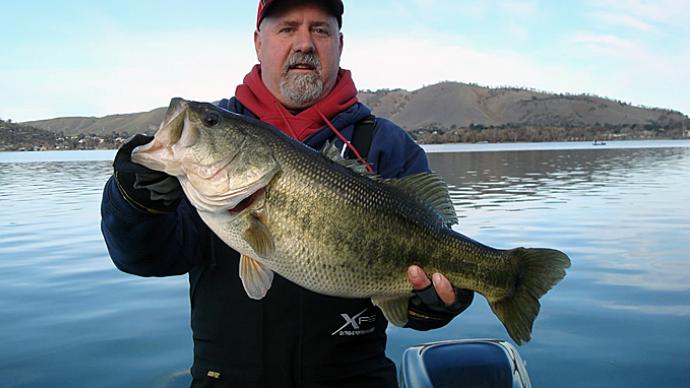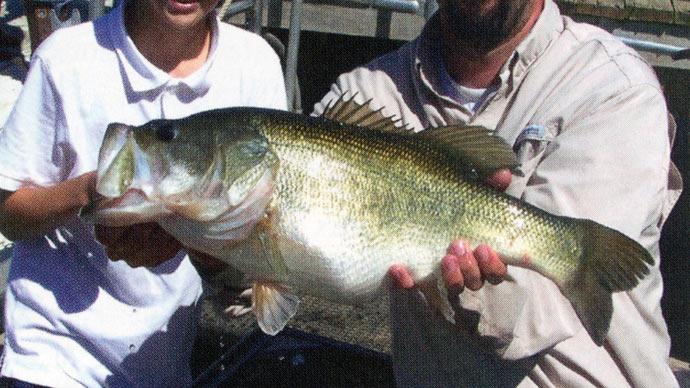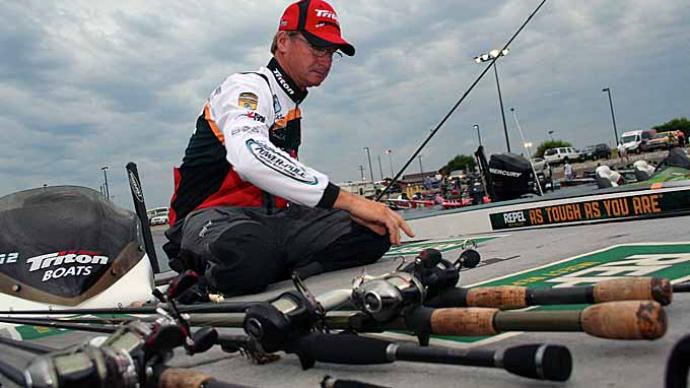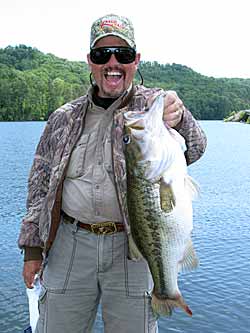
Before he became a famous fish tracker, with articles in BassResource or his book The Lost Bass, fishing for big bass was something about which John Hope already had intimate knowledge. After seeing a television program where another species of animal was tracked with electronic devices, he decided to do the same with largemouth bass. But not just any bass. He wanted to track the massive ones. So he purchased the equipment and set out to see where the fish would lead him and what their movements would tell him.
For almost a decade, his tracking experiments answered a need in John to know more about the private lives of the fish he, and many others, sought. With what he learned, he showed anglers how to catch fish in a manner that had never been presented before - from the perspective of the fish themselves.
The original study fish was Wanda, a 10-pounder in Houston County Lake caught in March of 1986, which he named for his wife. This fish provided a great deal of information to Hope, and we'll begin with her chronicles and share some of the information collected from the other fish as well.
February 1987
Nothing about her pattern has changed. For the past seven months, Wanda has remained stable in her movements (resting and feeding habits). She rests in 10 to 15 feet of water, then moves shallow to feed into three or four feet of depth. During the day, she hardly seems to move at all, then as feeding time nears, she moves to the creek and begins to prowl up and down the channel, moving parallel with the creek. She covers some 200 or 300 yards over several hours.
March 1987
During the feeding period, this fish never stops moving. She seems selective in what she eats and is alert to every element around her. Noise and other outside interferences, such as weather, disturb her usual movements. I caught her for the third time this month. She has gained over two pounds since the study began in 1986. We replaced her transmitter and weighed her at 12 pounds, eight ounces. She does not return now to her resting area, and at dinnertime, she is still in five to six feet of water. She is in pre-spawn mode. The water temperature is 58 degrees one day and drops to 54 over the next few days.
On March 8th, I located her in a small male bass nest, but a man on a nearby dock spooked her away. She returned about noon.
April 1987
Each day during March, she went into her same feeding territory until she began to feel the urge to spawn. Then, one day, she just stayed in that area. No drastic change in pattern. She remained there until she had laid her eggs. On April 9th, we caught her again and held her overnight in a tank at the marina. I looked at her the next morning, and she was gone. During the night, she jumped out and fell into the lake through a hole in the floor. I located her in Little Elkhart Creek, where she remained for four days. Then she went home, more than a mile and a half away. She returned to her regular patterns almost immediately.
During the study, John added several other fish to the program. They included a 3-pounder (Cathy), a 6-pounder (Debra), and one over 15 pounds (Missy) at Lake Fork. He also added a 14-pounder caught at Murvaul to the program.
May-July 1987
Home territories appear to be firmly established by all fish in the study. Feeding patterns are stable, and none of the fish vary their depth while feeding to more than 10 feet. However, there is a lot of difference in the structure where Wanda is in Houston County, and Missy is in Fork. Wanda roams open water while Missy stops at each tree stump for a few minutes. It appears that once a bass reaches seven pounds or more, they don't stay long in deep water unless suspended but are more likely to remain in mid- to shallow ranges.
August - October 1987
TPW ran a stratification test on Lake Fork and found that the lake was stratified at 17 feet. The oxygen levels below 17 feet were almost zero, which is why the fish moved shallow in the summer instead of deeper. There are at least three kinds of bass in our lakes. There are bass that stay shallow year-round, those that stay deep year-round, and those that remain more or less in the middle layer. The three will move into different layers, but their main comfort zones will be the layer they usually reside in and out of. Sad news, the taxidermist called. Wanda is in his shop. We caught her five times and followed her for over a year and a half before she was caught by someone who did not know she was a study fish. We learned a lot from her. Catch and release does work.
November, December 1987
None of the bass appear to have changed their patterns. When fronts move through, they move closer to the available structure. I finally tracked a fish that mainly stayed in deeper water when the lake de-stratified. She was suspended around 24 feet in 35 feet of water. There were several other fish with her close to the same size. This fish, too, moved only 300 or 400 yards along the creek to feed. So far, I have not found any fish that moves farther than that to feed.
January-March 1988
Trophy bass appear to be mainly homebodies, not venturing far from their spawning grounds. All of the large fish in the program appear to be roaming-type feeders. While the weather does not appear to affect big bass directly, it does affect their prey (baitfish), which is likely the main reason for any shifting in their everyday routines. Larger bass seem very particular about their food and prefer perch or larger food items most of the year.
In May 1998, a small male bass named Jonathan was implanted with a tracking transmitter at Houston County Lake. Another fish, a 12-pounder named Dee Dee, caught by Debbie Harrison of Cypress (at Houston County Lake), was added to the program. And John continued to track Missy and the others, with another 11-pounder added at Lake Fork.
During the time of John's tracking experiments, one major factor stood out above some of the other valuable data he collected, and that was that catch-and-release fishing did work. Not only did he catch the same fish several times, but he caught several fish the same way, and others caught fish he had released with transmitters in them.
He even tracked a bream for 90 days and found that bass and bream live harmoniously in the same structure and cover. Bream didn't seem to have patterns that differed much from the bass except that they abandoned their nests rather than guarded them as bass do.
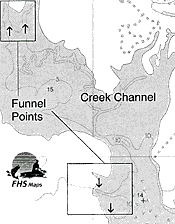
During his studies, John proved his theories on funnel points and the misconceptions of migrating bass. If you're not a long-time BassResource reader, that "funnel point" thing just pricked your ears up. If it didn't, it should. John's terminology came from his attempt to describe locations in a lake where trophy bass feed. He sat down with a map, marked all the places where he'd caught giant bass, and noticed they all had something in common. They looked like funnels. During a trip to Houston County Lake, he decided to test his theory and announced to all that he could mark ten places on the map where trophy fish had been caught. Professional guides and others with many years of fishing experience were among the crowd.
"After they all stopped snickering," says Hope, "I marked the map and let them take a look at it." But, of course, they all had to admit that every spot he marked was correct.
"If you look at a funnel, it has one very large end and one that's small. These are the types of locations you're looking for if you want to find big bass. The tighter the funnel and more narrow it becomes, the more likely it is to be traveled by some big bass. This mainly works because we have three types of fish in our lakes. There are shallow fish that remain from zero to 10 feet at all times and deep fish that stay from 10 to 20 feet or more. Many people document these two types, but my tracking studies helped me to find the third kind of fish, the one in the middle."
His studies on the movements of largemouth bass showed that the funnel didn't have to be close to shore to be a good one, either. And that mid-layer fish is more than likely the most dependable one in our lakes for continuous and predictable patterns.
"Weather conditions don't seem to bother these fish. They feed shallow but move out over deeper water and suspend until the urge to feed drives them shallow again. Then, they use the funnel points to move in to feed and move back out to the sanctuary over deep water. The process of locating these big bass can be applied to any lake. By studying a lake map and marking funnel-point areas, you can go out onto the water and graph the areas with your depth finder. If you spend the first hour and a half every morning or evening just sitting quietly on one of the funnel points you locate, you can catch several big bass."
Hope believes that some fishermen miss the opportunity to catch larger bass because their fishing habits remain unchanged. "After the spawn is when you need to move out farther and fish parallel to the shore," he says. "The fish we tracked stayed so close to their normal daily patterns throughout the year that it was almost scary. Deep-water fish resumed their daily shallows trips to feed following the spawn. Shallow fish resumed their normal routines, as did the mid-layer fish. The only interruption of their patterns occurred during the spawning cycle. And when that was over, they returned to doing what worked best for them for survival. After that, there would be slight changes during high-pressure periods. The fish might stay closer to cover but remain within their chosen areas. The only thing we found that made them move more than several hundred yards was the need to feed or the urge to spawn."
And when they move, they will use the traditional route, according to Hope, their funnel points, which is where you need to be to catch them.


